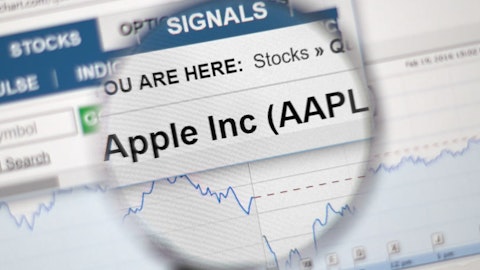Every company goes through cycles of ups and downs, and the downs are more pronounced for the 10 companies that failed to innovate and change. Because innovation is one of the most crucial things that separate continuously successful companies from flash-in-the-pan, declining ones.
For an example on how innovation transforms and grows a company, look at Netflix, Inc. (NASDAQ:NFLX). The company started in 1997 and initially made money by selling and renting DVDs by mail. It took Netflix until 2003 to post a profit. When DVD sales started to fall in 2006, Netflix could have doubled down on its core business, but instead it shifted its focus to developing a video-on-demand internet platform in 2007. By 2010, it had become the largest source of internet streaming traffic in the U.S. And when the media companies it partners with for movies and TV shows started to plan their own online video businesses to compete with Netflix, the company then started creating its own exclusive series and films, starting with the debut of “House of Cards” in 2013. This wisdom to constantly stay ahead of potential troubles has enabled Netflix to continue growing, to the point that it operates its internet streaming platform in almost every country in the world and has over 90 million subscribers.
Follow Netflix Inc (NASDAQ:NFLX)
Follow Netflix Inc (NASDAQ:NFLX)
Receive real-time insider trading and news alerts
Innovation is capable of not just saving companies from irrelevance, but also of solving global problems no matter how big they are. Be sure to check our list of the 10 biggest problems in the world that can be solved with inventions for more on that topic.

Onypix/Shutterstock.com
But not all tech companies (and corporations in general) are capable of innovating enough to thrive or even survive. For instance, remember Myspace? You used to have an account there, but you’ve since shifted to Facebook Inc (NASDAQ:FB), right? Surprisingly, Myspace is still an active website! But more on that later. Well, back in 2005, when Myspace was rapidly rising as one of the world’s leading websites, it offered to buy Facebook, but balked at Mark Zuckerberg’s $75 million price tag. No harm there in the beginning, because when Myspace started adding millions of users, it attracted a bidding war between media titans Sumner Redstone and Rupert Murdoch, with the latter securing the winning $580 million bid. In 2007, at the height of its powers, Myspace was valued at $12 billion. However, Myspace became stagnant, failing to create quality features or coming up with a cleaner web design, while rivals such as Facebook introduced better features. As a result, Myspace shed users at an alarming rate, and Murdoch ended up selling Myspace for just $35 million in 2011. The website now has only 36 million users, while Facebook is well past 1 billion.
Myspace aside (and forgotten), here is a list of 10 companies that failed to innovate and change, with short explanations on how those failures harmed the companies.
Blockbuster
You know this company as the brick-and-mortar chain that Netflix drove out of business because it could not transition in the internet age. Well, Blockbuster attempted to buy Netflix for $50 million in 2000 and was rebuffed. The company’s response to declining DVD sales was to shift to Blu-ray, still ignoring the internet. Unsurprisingly, the internet took Blockbuster down. Surprisingly, there are still 12 Blockbuster locations in the U.S.

JLRphotography/Shutterstock.com
Eastman Kodak Company Common New (NYSE:KODK)
The numerous ways that Kodak has fumbled would be enough for a list article of its own, but we’ll focus on a crucial mistake: the company actually created the first digital camera in 1976, but because it was afraid that the camera would cannibalize film sales, Kodak shelved the project. By the time it decided to sell digital cameras in the mid-2000s, it was undercut by rivals that could create cheaper cameras, while film sales continued to decline. In the end, Kodak went bankrupt in 2012. And now, let’s see what else we have in our list of companies that failed to innovate and change.

Cineberg/Shutterstock.com
Follow Eastman Kodak Co (NYSE:KODK)
Follow Eastman Kodak Co (NYSE:KODK)
Receive real-time insider trading and news alerts
Polaroid
Speaking of monoliths killed by digital cameras, Polaroid’s instant photography products proved no match for its high-tech rival. To its credit, the company sold digital cameras in 1996, with unsatisfactory results. The company filed for bankruptcy in 2001 and again in 2008.

BlackBerry Ltd (NASDAQ:BBRY)
Before Apple Inc. (NASDAQ:AAPL)‘s iPhone, there was the BlackBerry, the next one in our list of companies that failed to innovate and change. The company (then known as Research in Motion)’s lineup of phones had good features, spurring dramatic growth in the number of BlackBerry users, which reached 80 million in 2012. But since the start of this decade, the company has failed to create phones that matched up well with the products from other smartphone makers. As of March 2017, there are only 14 million BlackBerry users.

SGM / Shutterstock.com
Follow Blackberry Ltd (NYSE:BB)
Follow Blackberry Ltd (NYSE:BB)
Receive real-time insider trading and news alerts
Motorola Solutions Inc (NYSE:MSI)
The iPhone derailed not just BlackBerry phones but also two other phone makers (we’ll get to the other one later.) It seems like ages ago, but Motorola’s RAZR phones were the best-selling phones during the previous decade. However, the company failed to adapt fast enough to the smartphone age. Motorola ended up spinning off its phone business in 2011, wasting a golden opportunity that the record sales of the RAZR series had granted.

dokmai / Shutterstock.com
Follow Motorola Solutions Inc. (NYSE:MSI)
Follow Motorola Solutions Inc. (NYSE:MSI)
Receive real-time insider trading and news alerts
Nokia Oyj (ADR) (NYSE:NOK)
Speaking of squandered leads, Nokia could have adapted well in the smartphone age, with its extensive experience in offering best-selling phones. But for some reason, the phone maker ended up being a follower in the smartphone race, and made the mistake of picking Windows Phone software. The deal greatly diminished Nokia’s standing in the mobile space, making it one of the 10 companies that failed to innovate and change.

Hadrian / Shutterstock.com
Follow Nokia Corp (NYSE:NOK)
Follow Nokia Corp (NYSE:NOK)
Receive real-time insider trading and news alerts
Microsoft Corporation (NASDAQ:MSFT)
Speaking of Windows Phone, Microsoft the next one in our list of companies that failed to innovate and change had a so-called “lost decade,” during which the company went through a series of bad breaks. In almost every significant tech trend there was since 2000, Microsoft had the chance to compete, but it either fumbled in execution or simply opted not to get in. Make no mistake, Microsoft is still significant as a company, but it could have been set for even more success. The good news for the company is that things appear to be improving in this regard under current leader Satya Nadella, who has also cited Microsoft’s lack of innovation in the past. “It always bothered me that we confused an enduring mission with a temporal goal,” Nadella recently told USA Today in regards to the company’s mission of having a computer in every home.

Taina Sohlman / Shutterstock.com
Follow Microsoft Corp (NASDAQ:MSFT)
Follow Microsoft Corp (NASDAQ:MSFT)
Receive real-time insider trading and news alerts
Xerox Corp (NYSE:XRX)
In a more egregious case of the Microsoft scenario, Xerox had enough inventions in its Palo Alto Research Center (PARC) to single-handedly usher in the PC age. But the company kept those under the rug, fearing that they would cannibalize the sales of its lucrative photocopier business. Worse, Xerox gave away PARC’s innovations to Apple Inc. (NASDAQ:AAPL), Microsoft, and a host of other billion-dollar companies that owe some of their successes to Xerox’s negligence.

Copyright: smileus / 123RF Stock Photo
Follow Xerox Corp (NASDAQ:XRX)
Follow Xerox Corp (NASDAQ:XRX)
Receive real-time insider trading and news alerts
Borders
The demise of the once-mighty Borders bookstore chain can be traced to one thing: its failure to go online. Borders opted to outsource its website to Amazon.com, Inc. (NASDAQ:AMZN) and stick to its guns in the physical store space even as consumers shifted online, preferring e-books over their physical counterparts. By the time Borders made its own website in 2008 and offered e-books in 2010, it was headed to bankruptcy.

Comaniciu Dan/Shutterstock.com
Follow Amazon Com Inc (NASDAQ:AMZN)
Follow Amazon Com Inc (NASDAQ:AMZN)
Receive real-time insider trading and news alerts
US Postal Service
Speaking of industries defeated by the internet, the USPS was driven to irrelevance with the advent of email. That must have been very crushing, considering that the USPS could have been the company that invented and popularized email way back in the 1980s. It is definitely one of the unfortunate companies that failed to innovate and change.

Tupungato/Shutterstock.com
Disclosure: None





